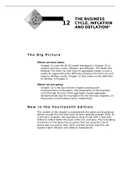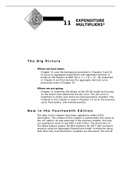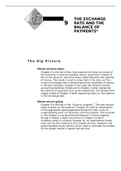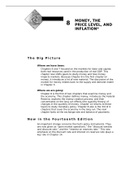Muhammadahsan
On this page, you find all documents, package deals, and flashcards offered by seller muhammadahsan.
- 13
- 0
- 0
Community
- Followers
- Following
13 items

Fiscal Policy
This chapter extensively uses the aggregate supply-aggregate demand model introduced in Chapter 10. It also makes use of Chapter 11’s discussion of multipliers. The material on the labor market and potential GDP from Chapter 6 is important when discussing the supply-side effects of fiscal policy. This chapter is rich with data, which has all been updated to 2020. The Economics in the News detail that compared the U.S. corporate tax rate with those in other countries has been eliminated. The...
- Class notes
- • 14 pages •
This chapter extensively uses the aggregate supply-aggregate demand model introduced in Chapter 10. It also makes use of Chapter 11’s discussion of multipliers. The material on the labor market and potential GDP from Chapter 6 is important when discussing the supply-side effects of fiscal policy. This chapter is rich with data, which has all been updated to 2020. The Economics in the News detail that compared the U.S. corporate tax rate with those in other countries has been eliminated. The...

The Business Cycle, Inflation and Deflation
Chapter 12 uses the AS-AD model developed in Chapter 10 to explore business cycles, inflation, and deflation. The distinction between the short-run and long-run aggregate supply curves is useful for appreciating the difference between the short-run and long-run Phillips curves. Chapter 12 also draws on the definition of inflation in Chapter 5. Chapter 12 is the last of three chapters dealing with macroeconomic fluctuations. The explanation of the business cycle through the lens of the aggregate...
- Class notes
- • 19 pages •
Chapter 12 uses the AS-AD model developed in Chapter 10 to explore business cycles, inflation, and deflation. The distinction between the short-run and long-run aggregate supply curves is useful for appreciating the difference between the short-run and long-run Phillips curves. Chapter 12 also draws on the definition of inflation in Chapter 5. Chapter 12 is the last of three chapters dealing with macroeconomic fluctuations. The explanation of the business cycle through the lens of the aggregate...

Expenditure Multipliers
Chapter 11 uses the background provided in Chapters 4 and 10 to focus on aggregate expenditure and aggregate demand. It builds on the division of GDP into C + I + G + (X – M) explained in Chapter 4 and then derives the aggregate demand curve previously used in Chapter 10. Chapter 11 examines the details of the AS-AD model by focusing on the factors that determine the AD curve. The AD curve is important in all the core short-run macroeconomic chapters. The material in this chapter is used i...
- Class notes
- • 18 pages •
Chapter 11 uses the background provided in Chapters 4 and 10 to focus on aggregate expenditure and aggregate demand. It builds on the division of GDP into C + I + G + (X – M) explained in Chapter 4 and then derives the aggregate demand curve previously used in Chapter 10. Chapter 11 examines the details of the AS-AD model by focusing on the factors that determine the AD curve. The AD curve is important in all the core short-run macroeconomic chapters. The material in this chapter is used i...

Aggregate Supply and Aggregate Demand
This chapter provides the work horse model, the aggregate supply-aggregate demand model, used to explore answers to the questions about short-run macroeconomic issues. The chapter uses the fact established in Chapter 4, that expenditure equals C + I + G + (X – M), to explain the forces that determine aggregate demand. It also draws on Chapter 3, demand and supply, for the crucial concepts of equilibrium and the distinction between shifts and movements along demand and supply curves. This chap...
- Class notes
- • 20 pages •
This chapter provides the work horse model, the aggregate supply-aggregate demand model, used to explore answers to the questions about short-run macroeconomic issues. The chapter uses the fact established in Chapter 4, that expenditure equals C + I + G + (X – M), to explain the forces that determine aggregate demand. It also draws on Chapter 3, demand and supply, for the crucial concepts of equilibrium and the distinction between shifts and movements along demand and supply curves. This chap...

THE EXCHANGE RATE AND THE BALANCE OF PAYMENTS
Chapter 9 is the last of four that examine the long-run trends of the economy. It uses the quantity theory result from Chapter 8 that in the long run, the price level is determined by the quantity of money. This result is used to show that in the long run, the nominal exchange rate is determined by the quantities of money in the two countries. Chapter 9 also uses the national income accounting identities introduced in Chapter 4 when explaining the balance of payments and, quite importantly, the ...
- Class notes
- • 19 pages •
Chapter 9 is the last of four that examine the long-run trends of the economy. It uses the quantity theory result from Chapter 8 that in the long run, the price level is determined by the quantity of money. This result is used to show that in the long run, the nominal exchange rate is determined by the quantities of money in the two countries. Chapter 9 also uses the national income accounting identities introduced in Chapter 4 when explaining the balance of payments and, quite importantly, the ...

Monitoring Jobs and Inflation
This chapter increases students’ understanding of the types and sources of unemployment. It also provides students with detail on the use of the CPI to measure inflation. Alternative price measures also are introduced. Perhaps more significantly, the explanation of the natural rate of unemployment and its relationship to potential GDP are important building blocks for the AS-AD model developed in Chapter 10 and the Phillips curve framework developed in Chapter 12. These topics also recur in Ch...
- Class notes
- • 17 pages •
This chapter increases students’ understanding of the types and sources of unemployment. It also provides students with detail on the use of the CPI to measure inflation. Alternative price measures also are introduced. Perhaps more significantly, the explanation of the natural rate of unemployment and its relationship to potential GDP are important building blocks for the AS-AD model developed in Chapter 10 and the Phillips curve framework developed in Chapter 12. These topics also recur in Ch...

Measuring the Value of Production GDP with solved Exercise
Chapter 4 is the first of the macroeconomic chapters. It provides some basic definitions (GDP, real GDP, aggregate expenditure, potential GDP, and business cycles) that are used in virtually all the remaining chapters. The circular flow model and the national income accounting explained in this chapter serve as a general framework for macroeconomic analysis. The figures that show that aggregate expenditure equals aggregate income which all equals the value of production is the key to understandi...
- Class notes
- • 20 pages •
Chapter 4 is the first of the macroeconomic chapters. It provides some basic definitions (GDP, real GDP, aggregate expenditure, potential GDP, and business cycles) that are used in virtually all the remaining chapters. The circular flow model and the national income accounting explained in this chapter serve as a general framework for macroeconomic analysis. The figures that show that aggregate expenditure equals aggregate income which all equals the value of production is the key to understandi...

Demand and Supply Detail notes
Demand and supply lie at the heart of the principles course. Eventually in the microeconomics class we derive the demand curve and the supply curve from deeper views of the choices that people and firms make. And in the macroeconomic class, the lessons learned here apply, albeit with subtle differences, to the aggregate supply-aggregate demand model.
- Class notes
- • 22 pages •
Demand and supply lie at the heart of the principles course. Eventually in the microeconomics class we derive the demand curve and the supply curve from deeper views of the choices that people and firms make. And in the macroeconomic class, the lessons learned here apply, albeit with subtle differences, to the aggregate supply-aggregate demand model.

The Economic Problem notes With solved Exercise
The Economic Problem With solved Exercise Chapter 1 introduced the economic reality that wants exceed the resources available to satisfy them—we face scarcity. Chapter 2 reinforces these central themes by laying out the core economic model, the Production Possibilities Frontier, or PPF, and uses it to illustrate the concepts of tradeoff and opportunity cost. Chapter 2 further details the concepts of marginal cost and marginal benefit, presenting a first look at the concept of efficiency. The ...
- Class notes
- • 20 pages •
The Economic Problem With solved Exercise Chapter 1 introduced the economic reality that wants exceed the resources available to satisfy them—we face scarcity. Chapter 2 reinforces these central themes by laying out the core economic model, the Production Possibilities Frontier, or PPF, and uses it to illustrate the concepts of tradeoff and opportunity cost. Chapter 2 further details the concepts of marginal cost and marginal benefit, presenting a first look at the concept of efficiency. The ...

Money, The Price Level, and Inflation
Chapter 8 is the first of two chapters that examine money and the economy. This chapter defines money, introduces the Federal Reserve, explains the money creation process, and then concentrates on the long run effects (the quantity theory) of changes in the quantity of money. Chapter 14 returns to these topics to study monetary policy. Chapter 8 also is the 3rd of 4 chapters that cover the economy in the long run. The next chapter looks at the exchange rate and balance of payments. An importa...
- Class notes
- • 20 pages •
Chapter 8 is the first of two chapters that examine money and the economy. This chapter defines money, introduces the Federal Reserve, explains the money creation process, and then concentrates on the long run effects (the quantity theory) of changes in the quantity of money. Chapter 14 returns to these topics to study monetary policy. Chapter 8 also is the 3rd of 4 chapters that cover the economy in the long run. The next chapter looks at the exchange rate and balance of payments. An importa...
